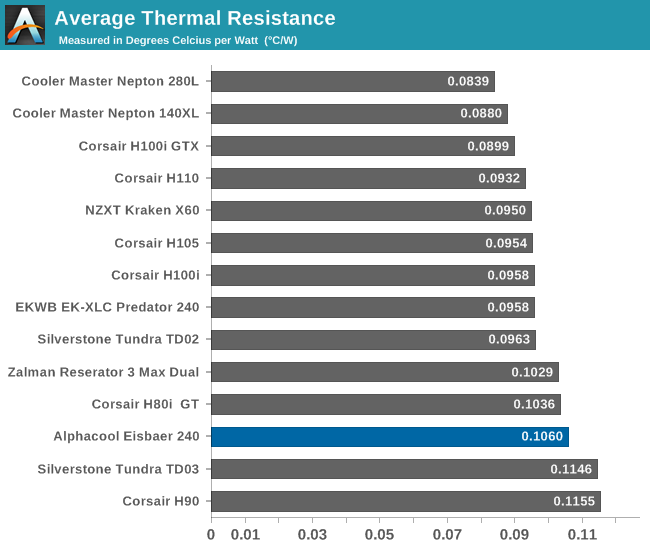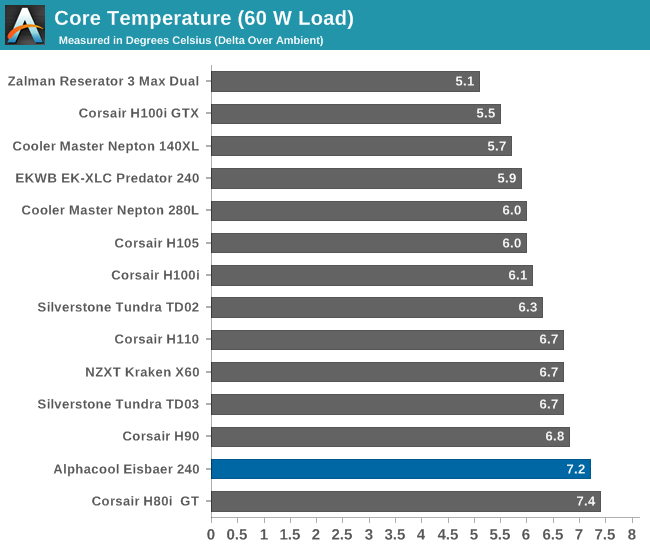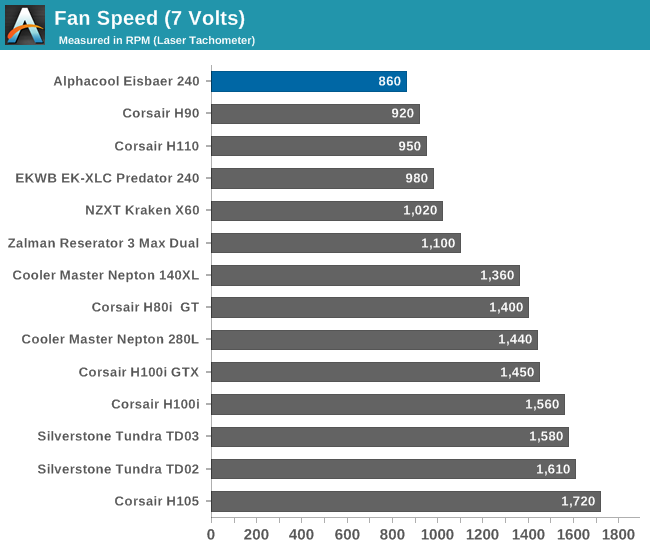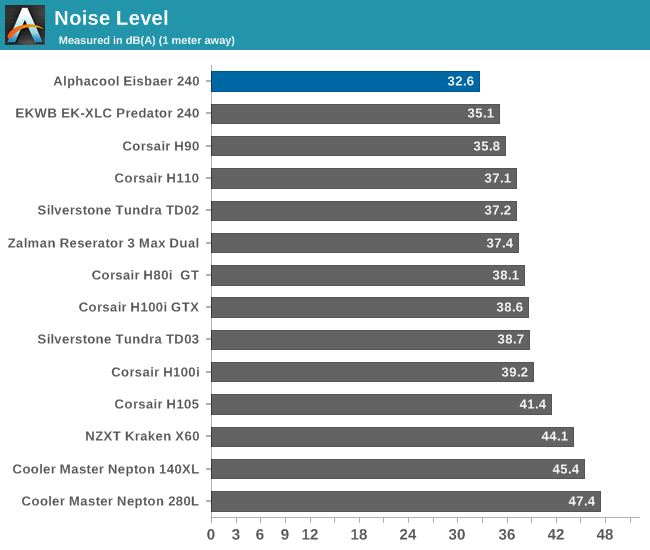The Alphacool Eisbaer 240 CPU AIO Liquid Cooler Review
by E. Fylladitakis on August 1, 2016 9:00 AM EST- Posted in
- Cases/Cooling/PSUs
- AIO
- Water Cooling
- Cooler
- Alphacool
Testing Results, Low Fan Speed (7 Volts)
The quiet fans of the Eisbaer 240 have their speed greatly reduced with an input voltage of 7 Volts, down to just 810 RPM. These fans can hardly generate any pressure at such a low speed so, naturally, the thermal performance of the Eisbaer 240 is now reduced significantly. With the average thermal performance reduced down to 0.106 °C/W, the Eisbaer 240 is now outperformed by every dual 120 mm AIO cooler that we have tested to this date.


| Core Temperature, Constant Thermal Load (Low Fan Speed) |
Nevertheless, the average thermal resistance of 0.106 °C/W is not actually bad considering that the Eisbaer 240 is virtually noiseless under these operating conditions. Our instruments recorded just 32.6 dB(A) from a distance of one meter, only 2.2 dB(A) higher than our floor noise level and a figure that it is not easily discernible by human ears inside a normal room. It is possible to discern low humming noises only from a distance of a few centimeters away from the fans and/or the pump.












69 Comments
View All Comments
ikjadoon - Tuesday, August 2, 2016 - link
This idea just doesn't die.Quieter and cooler and cheaper than a Noctua NH-U14S.
http://www.hardocp.com/article/2016/02/11/arctic_c...
Azune - Monday, August 1, 2016 - link
He should have said best noise/thermal performance for 240mm radiators. Because larger radiator and larger fans will always win in this metric. (H110 is a 280mm)BrokenCrayons - Monday, August 1, 2016 - link
Pass on the water cooling. I don't like the idea of mixing liquid and electricity for no tangible benefit over the HSF that was included in the box. Yes, sure the temperature of the processor is lower, but who cares really? As long as it's not above the manufacturer's spec, temperature makes literally no difference to me. I can understand wanting to cut back on noise and that might warrant an upgraded air cooler over the retail boxed one, but even then, a lot of the reasoning behind that ignores ambient noise of HVAC, other people, and blaring televisions which would drown out the relatively small amount of noise from a stock cooler.ikjadoon - Tuesday, August 2, 2016 - link
Why are you even reading this review? LOL. It's like a guy who drives a Camry walking into an aftermarket parts store: "A turbocharger? I don't like the idea of mixing more air. Sure, the horsepower is higher, but who cares really?"Wrong review and maybe even wrong website, dude. :D
BrokenCrayons - Wednesday, August 3, 2016 - link
What is it with men and comparing everything to a car? Is it really that ingrained into the brain wiring that guys who were given little toys to push around as toddlers that then grow into grade school students who drive imaginary cars down the hallway while making engine sounds with their mouths end up seeing their world as adults through the view of a windshield? Nah nevermind, let's not delve into psychology here, it'd be a waste of time.Anyway "dude," have you read many articles on this site? AT doesn't cater specifically to the audience you think it does and perceive that you fall within. In my opinion, that's one of the nice things about Anandtech. It's writers explore a wider range of technology in greater depth than do the dinosaurs of the desktop computer era that have yet to realize that overclocking and tinkering is now well controlled by hardware manufacturers that manage even that experience to the point where it's basically a walled off sandbox that only leaves buyers with the impression their extra expenditure is giving them something more rather than genuinely rewarding them with something worthwhile.
BrokenCrayons - Wednesday, August 3, 2016 - link
What is it with men and comparing everything to a car? Is it really that ingrained into the brain wiring that guys who were given little toys to push around as toddlers that then grow into grade school students who drive imaginary cars down the hallway while making engine sounds with their mouths end up seeing their world as adults through the view of a windshield? Nah nevermind, let's not delve into psychology here, it'd be a waste of time.Anyway "dude," have you read many articles on this site? AT doesn't cater specifically to the audience you think it does and perceive that you fall within. In my opinion, that's one of the nice things about Anandtech. It's writers explore a wider range of technology in greater depth than do the dinosaurs of the desktop computer era that have yet to realize that overclocking and tinkering is now well controlled by hardware manufacturers that manage even that experience to the point where it's basically a walled off sandbox that only leaves buyers with the impression their extra expenditure is giving them something more rather than genuinely rewarding them with something worthwhile.
JeffFlanagan - Monday, August 1, 2016 - link
I used to liquid cool and overclock, until a tiny leak destroyed a motherboard and CPU years ago.These days my PCs are so fast that I don't need to overclock, but if I wanted to, I wouldn't even try it unless the cooling liquid has a low enough boiling point to be MUCH more effective than air-cooling, like the liquid cooling used in some tablets.
Death666Angel - Monday, August 1, 2016 - link
"like the liquid cooling used in some tablets."You mean vapor chamber technology, which has been in use for several years in the PC space already and is in pretty much no way comparable to water based liquid cooling which is typically meant when talking about liquid cooling? Totally different technologies which shouldn't be conflated at all.
Death666Angel - Monday, August 1, 2016 - link
And I forgot to add to your "MUCH more effective than air-cooling" point. If you indeed mean vapor chamber technology, that is only effective in drawing heat away from the chips that create the heat. That heat needs to be transferred to somewhere where it can be taken out of the system (unless the heatsink attached via vapor chamver is literally the size of the wall around your room) and that is usually done via air cooling, i.e. having a lot of metal fins oriented in a way that a fan can push or pull air through them to cool them. So nothing magical about it.maximumGPU - Tuesday, August 2, 2016 - link
I'd appreciate if anyone can answer this:Can you make a custom loop cool better AND be quieter than a high end air tower?
Unfortunately I can only find contradicting opinions on this, anybody with direct experience cares to pitch in?